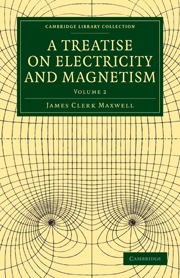Book contents
- Frontmatter
- Contents
- PART III MAGNETISM
- PART IV ELECTROMAGNETISM
- CHAPTER I ELECTROMAGNETIC FORCE
- CHAPTER II MUTUAL ACTION OF ELECTRIC CURRENTS
- CHAPTER III INDUCTION OF ELECTRIC CURRENTS
- CHAPTER IV INDUCTION OF A CURRENT ON ITSELF
- CHAPTER V GENERAL EQUATIONS OF DYNAMICS
- CHAPTER VI APPLICATION OF DYNAMICS TO ELECTROMAGNETISM
- CHAPTER VII ELECTROKINETICS
- CHAPTER VIII EXPLORATION OF THE FIELD BY MEANS OF THE SECONDARY CIRCUIT
- CHAPTER IX GENERAL EQUATIONS
- CHAPTER X DIMENSIONS OF ELECTRIC UNITS
- CHAPTER XI ENERGY AND STRESS
- CHAPTER XII CURRENT-SHEETS
- CHAPTER XIII PARALLEL CURRENTS
- CHAPTER XIV CIRCULAR CURRENTS
- CHAPTER XV ELECTROMAGNETIC INSTRUMENTS
- CHAPTER XVI ELECTROMAGNETIC OBSERVATIONS
- CHAPTER XVII ELECTRICAL MEASUREMENT OF COEFFICIENTS OF INDUCTION
- CHAPTER XVIII DETERMINATION OF RESISTANCE IN ELECTROMAGNETIC MEASURE
- CHAPTER XIX COMPARISON OF ELECTROSTATIC WITH ELECTROMAGNETIC UNITS
- CHAPTER XX ELECTROMAGNETIC THEORY OF LIGHT
- CHAPTER XXI MAGNETIC ACTION ON LIGHT
- CHAPTER XXII ELECTRIC THEORY OF MAGNETISM
- CHAPTER XXIII THEORIES OF ACTION AT A DISTANCE
- INDEX
- Plate section
CHAPTER XXII - ELECTRIC THEORY OF MAGNETISM
Published online by Cambridge University Press: 05 July 2011
- Frontmatter
- Contents
- PART III MAGNETISM
- PART IV ELECTROMAGNETISM
- CHAPTER I ELECTROMAGNETIC FORCE
- CHAPTER II MUTUAL ACTION OF ELECTRIC CURRENTS
- CHAPTER III INDUCTION OF ELECTRIC CURRENTS
- CHAPTER IV INDUCTION OF A CURRENT ON ITSELF
- CHAPTER V GENERAL EQUATIONS OF DYNAMICS
- CHAPTER VI APPLICATION OF DYNAMICS TO ELECTROMAGNETISM
- CHAPTER VII ELECTROKINETICS
- CHAPTER VIII EXPLORATION OF THE FIELD BY MEANS OF THE SECONDARY CIRCUIT
- CHAPTER IX GENERAL EQUATIONS
- CHAPTER X DIMENSIONS OF ELECTRIC UNITS
- CHAPTER XI ENERGY AND STRESS
- CHAPTER XII CURRENT-SHEETS
- CHAPTER XIII PARALLEL CURRENTS
- CHAPTER XIV CIRCULAR CURRENTS
- CHAPTER XV ELECTROMAGNETIC INSTRUMENTS
- CHAPTER XVI ELECTROMAGNETIC OBSERVATIONS
- CHAPTER XVII ELECTRICAL MEASUREMENT OF COEFFICIENTS OF INDUCTION
- CHAPTER XVIII DETERMINATION OF RESISTANCE IN ELECTROMAGNETIC MEASURE
- CHAPTER XIX COMPARISON OF ELECTROSTATIC WITH ELECTROMAGNETIC UNITS
- CHAPTER XX ELECTROMAGNETIC THEORY OF LIGHT
- CHAPTER XXI MAGNETIC ACTION ON LIGHT
- CHAPTER XXII ELECTRIC THEORY OF MAGNETISM
- CHAPTER XXIII THEORIES OF ACTION AT A DISTANCE
- INDEX
- Plate section
Summary
On Electromagnetic Theories of Magnetism.
832.] We have seen (Art. 380) that the action of magnets on one another can be accurately represented by the attractions and repulsions of an imaginary substance called ‘magnetic matter.’ We have shewn the reasons why we must not suppose this magnetic matter to move from one part of a magnet to another through a sensible distance, as at first sight it appears to do when we magnetize a bar, and we were led to Poisson's hypothesis that the magnetic matter is strictly confined to single molecules of the magnetic substance, so that a magnetized molecule is one in which the opposite kinds of magnetic matter are more or less separated towards opposite poles of the molecule, but so that no part of either can ever be actually separated from the molecule (Art. 430).
These arguments completely establish the fact, that magnetization is a phenomenon, not of large masses of iron, but of molecules, that is to say, of portions of the substance so small that we cannot by any mechanical method cut one of them in two, so as to obtain a north pole separate from a south pole. But the nature of a magnetic molecule is by no means determined without further investigation.
- Type
- Chapter
- Information
- A Treatise on Electricity and Magnetism , pp. 418 - 425Publisher: Cambridge University PressPrint publication year: 2010First published in: 1873



